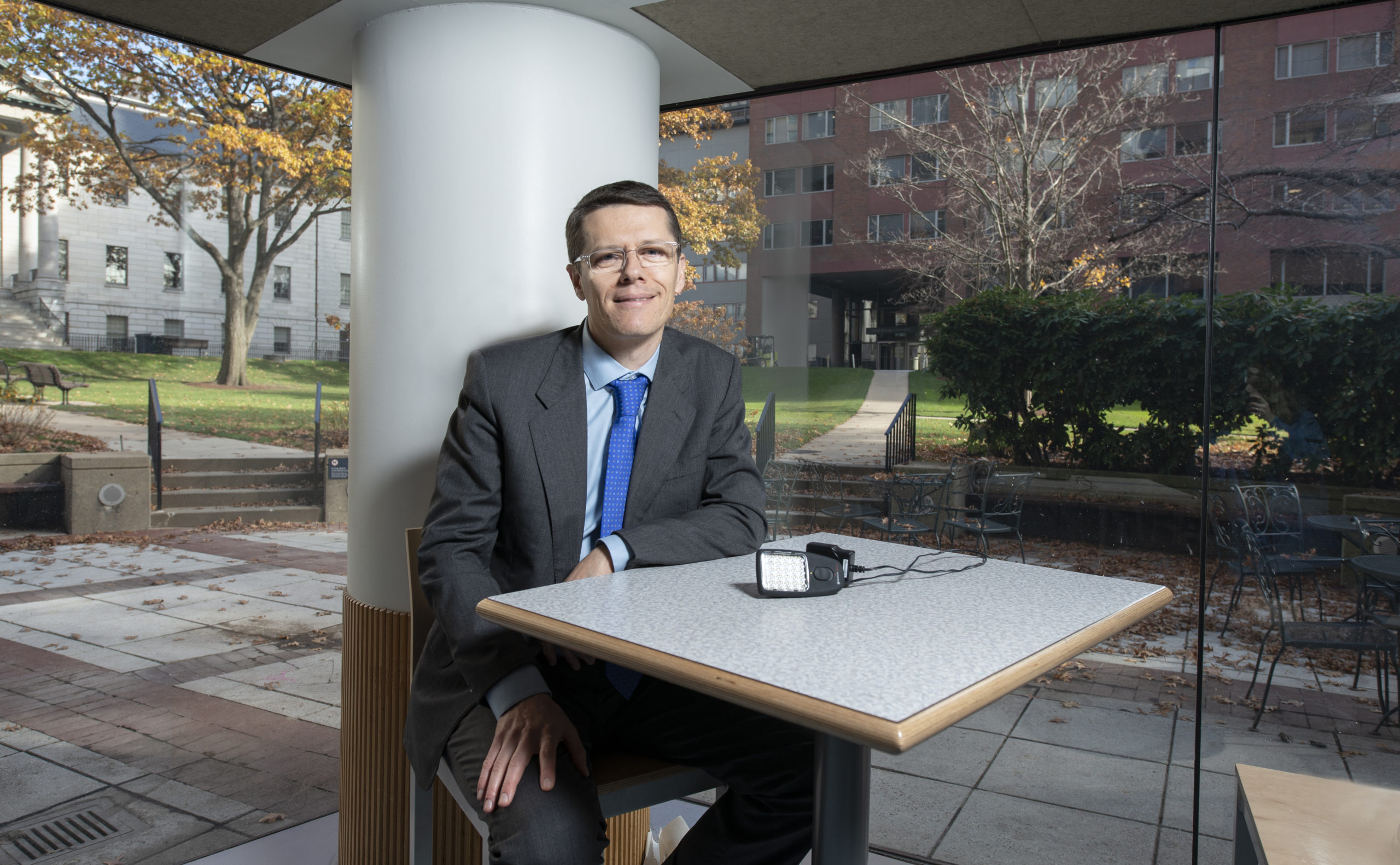Leaning forward to place an unusual looking headset onto a person reclining in a chair, Paolo Cassano, MD, PhD, describes how he will bathe her brain in invisible infrared light — a new approach to relieving depression called photobiomodulation.
Invisible infrared light stimulates brain cells to produce energy so the brain can carry out its activities at a normal level.
The patient will see no light, hear no sound, but will rest in peaceful darkness for 20 minutes while the light penetrates a centimeter into the cerebral cortex — the frontal lobe of the brain.
“The brain needs a lot of energy,” says Dr. Cassano, a psychiatrist in the Depression and Clinical Research program of the Department of Psychiatry at Massachusetts General Hospital. Experts believe one cause of depression may be a disorder of brain metabolism — low brain energy.
The infrared light stimulates brain cells (neurons) to produce energy so the brain can carry out its activities at a normal level.
A Therapeutic Mismatch
People with depression often reject the idea of taking medication, Dr. Cassano says. And there is a shortage of therapists trained in the proven methods of cognitive behavioral therapy, a form of talk therapy that helps patients identify negative thinking patterns.

“So you have a clear need,” he says, “and yet there is a mismatch between the treatments we have and what people are willing to accept.”
Knowing that full-spectrum light therapy can help relieve seasonal depression, he wondered about using infrared light — which has been used to treat symptoms of stroke, pain and aging skin — for major depression in patients who are reluctant to take medication.
Collaborating with experts at the Mass General Wellman Center for Photomedicine, he devised a study to test a safe, infrared light device in patients with major depression.
Early results have shown significant success. In a small trial of 21 people diagnosed with major depression, most who received the invisible light therapy experienced significant improvement in mood during a series of treatments compared with those who received a “sham” treatment in which they wore the headset but received no light.
These encouraging findings and the minimal risks associated with infrared light led Dr. Cassano to start the MGH Psychiatry Photobiomodulation Clinic for the off-label therapeutic use of near-infrared light on the brain. This clinic offers near-infrared light therapy to patients who either did not tolerate, respond to or accept conventional neuropsychiatric treatments.
“This research is in such a young stage, even a small contribution can make a big difference.”
Invisible Infrared Light
Sharas Apichainimitdee, a 33-year-old man who goes by the nickname Joey, came to see Dr. Cassano when he lost his interest and motivation to do things. He had little energy and preferred to be alone. His depressive symptoms were the result of MELAS complex I deficiency, a disorder of the mitochondria, the part the cell that produces energy.
Joey received a total of four sessions of invisible light and soon began feeling better. His mood improved: “I felt peppier,” he says. His motivation to do things increased.
“He was up and going and energetic after the therapy,” says his mother, Nancee Apichainimitdee. He saw other improvements as well. His speech improved and he could participate more in family conversations. He experienced some headaches, possibly related to the infrared light sessions, and some muscle fatigue and weakness after being more active.

• Helping Camy Be Camy Again: One Girl’s Battle with PANDAS
• Mass General Launches Neuroscience Initiative
• How to Cope with Generalized Anxiety Disorder
• Center for Bipolar Disorder has Global Reach
Joey’s case raises the possibility that invisible light therapy could be helpful to treat not only depression but also mood changes that accompany some mitochondrial diseases, Dr. Cassano says. The near-infrared light has the potential to bypass the limiting step of the energy flow in the mitochondria and to adequately power the cells.
The Role of Philanthropy
While still in its early testing stage, Dr. Cassano is moving ahead with new trials. How photobiomodulation works is under investigation. Stimulating brain metabolism may cause an antioxidant response which relieves damaging oxidative stress, he explains.
There is also a reduction in cell death in the brain and a reduction in inflammation in the brain. “All of these are implicated in causing brain disorders,” he says.
He is also watching for side effects in patients. Some patients report seeing brighter visual effects and others increased sexual response. That’s a good thing, says Dr. Cassano who points out that many psychotropic medications, such as antidepressants, depress sexual activity.
The small studies Dr. Cassano is doing are building blocks. The goal is to do the research to build the biological foundation that can lead to major grants for large-scale studies. Philanthropic support is needed.
“This research is in such a young stage,” he says, “even a small contribution can make a big difference.”
For more information about invisible light therapy, or to make a donation, please contact us.





